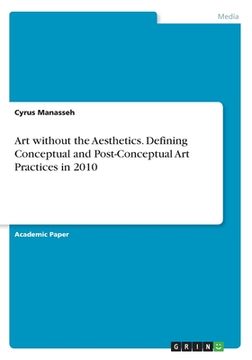Share
Art without the Aesthetics. Defining Conceptual and Post-Conceptual Art Practices in 2010 (in English)
Cyrus Manasseh
(Author)
·
Grin Verlag
· Paperback
Art without the Aesthetics. Defining Conceptual and Post-Conceptual Art Practices in 2010 (in English) - Manasseh, Cyrus
$ 29.93
$ 37.90
You save: $ 7.97
Choose the list to add your product or create one New List
✓ Product added successfully to the Wishlist.
Go to My WishlistsIt will be shipped from our warehouse between
Tuesday, May 21 and
Wednesday, May 22.
You will receive it anywhere in United States between 1 and 3 business days after shipment.
Synopsis "Art without the Aesthetics. Defining Conceptual and Post-Conceptual Art Practices in 2010 (in English)"
Academic Paper from the year 2010 in the subject Art - Art Theory, General, The University of Western Australia, language: English, abstract: The paper focuses on explaining why today (conceptual) and post-conceptual art practices generated from specific theories during the 1960s and 1970s would precipitate the need for the decline of philosophical aesthetics in discussing today's contemporary art. Today, since "aesthetic experience is to be conceived as conforming to the ruling cultural ideology" much of the "visual turn", would derive from street artists, sub-cultures and darker cultures who, rebellious by nature use (conceptual) and post-conceptual art practices, which increasingly produce theoretical positions, which contribute to the discursive paradigms adopted by today's theoreticians of visual culture. Also contributing to the "visual turn", is the active role played by gallery audiences who help to produce the meaning of the work itself-their role now has largely changed from passive contemplation to active participation. The paper defines why the preponderance of perspectives accumulated today (used by theoreticians of visual culture) informed by the artist's intention as a new theory in itself and the audience as "participant" is currently outweighing the significance of aesthetic theory. In the paper, I define and evaluate why philosophical aesthetics is no longer being seen as necessary to provide critical reflection of new media, post-conceptual art practices and the digital revolution.
- 0% (0)
- 0% (0)
- 0% (0)
- 0% (0)
- 0% (0)
All books in our catalog are Original.
The book is written in English.
The binding of this edition is Paperback.
✓ Producto agregado correctamente al carro, Ir a Pagar.

